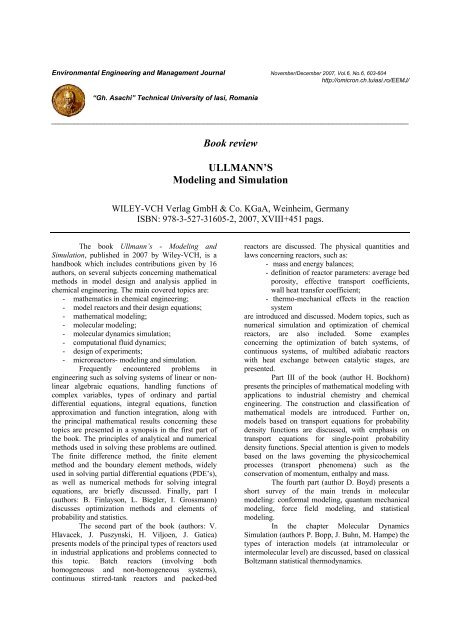2007_6_Nr6_EEMJ
Create successful ePaper yourself
Turn your PDF publications into a flip-book with our unique Google optimized e-Paper software.
Environmental Engineering and Management Journal November/December <strong>2007</strong>, Vol.6, No.6, 603-604<br />
http://omicron.ch.tuiasi.ro/<strong>EEMJ</strong>/<br />
“Gh. Asachi” Technical University of Iasi, Romania<br />
______________________________________________________________________________________________<br />
Book review<br />
ULLMANN’S<br />
Modeling and Simulation<br />
WILEY-VCH Verlag GmbH & Co. KGaA, Weinheim, Germany<br />
ISBN: 978-3-527-31605-2, <strong>2007</strong>, XVIII+451 pags.<br />
The book Ullmann’s - Modeling and<br />
Simulation, published in <strong>2007</strong> by Wiley-VCH, is a<br />
handbook which includes contributions given by 16<br />
authors, on several subjects concerning mathematical<br />
methods in model design and analysis applied in<br />
chemical engineering. The main covered topics are:<br />
- mathematics in chemical engineering;<br />
- model reactors and their design equations;<br />
- mathematical modeling;<br />
- molecular modeling;<br />
- molecular dynamics simulation;<br />
- computational fluid dynamics;<br />
- design of experiments;<br />
- microreactors- modeling and simulation.<br />
Frequently encountered problems in<br />
engineering such as solving systems of linear or nonlinear<br />
algebraic equations, handling functions of<br />
complex variables, types of ordinary and partial<br />
differential equations, integral equations, function<br />
approximation and function integration, along with<br />
the principal mathematical results concerning these<br />
topics are presented in a synopsis in the first part of<br />
the book. The principles of analytical and numerical<br />
methods used in solving these problems are outlined.<br />
The finite difference method, the finite element<br />
method and the boundary element methods, widely<br />
used in solving partial differential equations (PDE’s),<br />
as well as numerical methods for solving integral<br />
equations, are briefly discussed. Finally, part I<br />
(authors: B. Finlayson, L. Biegler, I. Grossmann)<br />
discusses optimization methods and elements of<br />
probability and statistics.<br />
The second part of the book (authors: V.<br />
Hlavacek, J. Puszynski, H. Viljoen, J. Gatica)<br />
presents models of the principal types of reactors used<br />
in industrial applications and problems connected to<br />
this topic. Batch reactors (involving both<br />
homogeneous and non-homogeneous systems),<br />
continuous stirred-tank reactors and packed-bed<br />
reactors are discussed. The physical quantities and<br />
laws concerning reactors, such as:<br />
- mass and energy balances;<br />
- definition of reactor parameters: average bed<br />
porosity, effective transport coefficients,<br />
wall heat transfer coefficient;<br />
- thermo-mechanical effects in the reaction<br />
system<br />
are introduced and discussed. Modern topics, such as<br />
numerical simulation and optimization of chemical<br />
reactors, are also included. Some examples<br />
concerning the optimization of batch systems, of<br />
continuous systems, of multibed adiabatic reactors<br />
with heat exchange between catalytic stages, are<br />
presented.<br />
Part III of the book (author H. Bockhorn)<br />
presents the principles of mathematical modeling with<br />
applications to industrial chemistry and chemical<br />
engineering. The construction and classification of<br />
mathematical models are introduced. Further on,<br />
models based on transport equations for probability<br />
density functions are discussed, with emphasis on<br />
transport equations for single-point probability<br />
density functions. Special attention is given to models<br />
based on the laws governing the physicochemical<br />
processes (transport phenomena) such as the<br />
conservation of momentum, enthalpy and mass.<br />
The fourth part (author D. Boyd) presents a<br />
short survey of the main trends in molecular<br />
modeling: conformal modeling, quantum mechanical<br />
modeling, force field modeling, and statistical<br />
modeling.<br />
In the chapter Molecular Dynamics<br />
Simulation (authors P. Bopp, J. Buhn, M. Hampe) the<br />
types of interaction models (at intramolecular or<br />
intermolecular level) are discussed, based on classical<br />
Boltzmann statistical thermodynamics.


